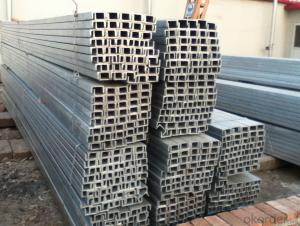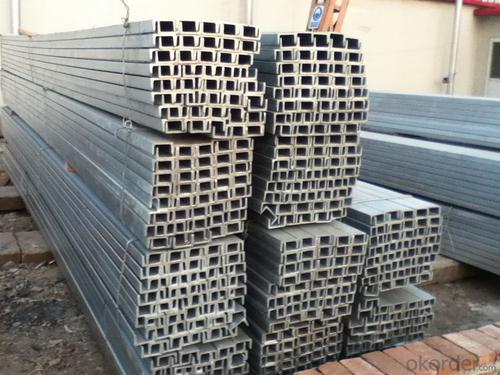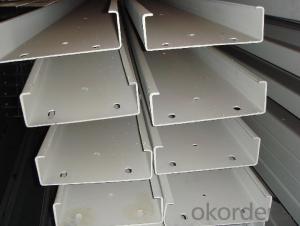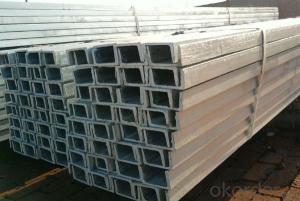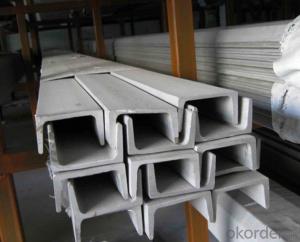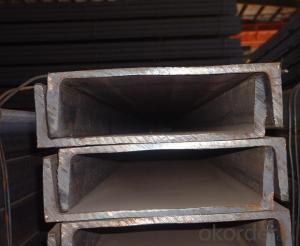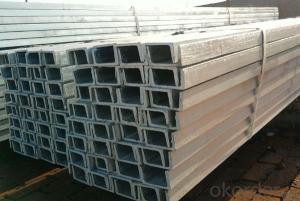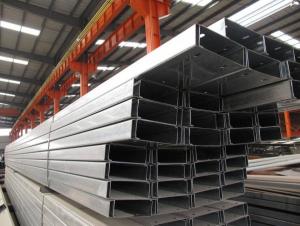High quality channel for JIS and GB standard
- Loading Port:
- Tianjin
- Payment Terms:
- TT OR LC
- Min Order Qty:
- 25 m.t.
- Supply Capability:
- 20000000 m.t./month
OKorder Service Pledge
OKorder Financial Service
You Might Also Like
Product Description:
Product Description:
Specifications of MS Channel:
1.We supply high quality MS Channel at reasonable price, including Chinese standard, Japanese standard and so on.
Standard | GB/JIS |
Material Grade | Q235,SS400 |
Technique: | Hot Rolled |
Sizes as per chinese standard: | 50*37*4.5mm - 300*89*11.5mm |
Sizes as per japanese standard: | 50*25*3mm – 200*80*7.5mm |
Length: | 6meter, 9meter, 12meter |
Note: 1.we are also competent to provide our customers other MS Channel based on other sizes according to customer’s requirements.
2. The length of our ms channel could be cut into other meters as per customer’s requirements. For example, the channel in 6meters could be cut into 5.8meters in order to be fit in the 20ft container.
2. The detailed sections of MS Channel as per GB standard.are shown in the table-1:
GB U CHANNEL | Standard | Sectional | Dimension |
| Mass: |
(mm) | (mm) | (mm) | (mm) | ||
50X37 | 50 | 37 | 4.50 | 7.0 | 5.438 |
63X40 | 63 | 40 | 4.80 | 7.5 | 6.634 |
80x43 | 80 | 43 | 5.00 | 8.0 | 8.045 |
100x48 | 100 | 48 | 5.30 | 8.5 | 10.007 |
120x53 | 120 | 53 | 5.50 | 9.0 | 12.059 |
140x58 | 140 | 58 | 6.00 | 9.5 | 14.535 |
140x60 | 140 | 60 | 8.00 | 9.5 | 16.733 |
160x63 | 160 | 63 | 6.50 | 10.0 | 17.240 |
160x65 | 160 | 65 | 8.50 | 10.0 | 19.752 |
180x68 | 180 | 68 | 7.00 | 10.5 | 20.174 |
180x70 | 180 | 70 | 9.00 | 10.5 | 23.000 |
200x73 | 200 | 73 | 7.00 | 11.0 | 22.637 |
200x75 | 200 | 75 | 9.00 | 11.0 | 25.777 |
220x77 | 220 | 77 | 7.00 | 11.5 | 24.999 |
220x79 | 220 | 79 | 9.00 | 11.5 | 28.453 |
250x78 | 250 | 78 | 7.00 | 12.0 | 27.410 |
250x80 | 250 | 80 | 9.00 | 12.0 | 31.335 |
250x82 | 250 | 82 | 11.00 | 12.0 | 35.260 |
280x82 | 280 | 82 | 7.50 | 12.5 | 31.427 |
280x84 | 280 | 84 | 9.50 | 12.5 | 35.823 |
280x86 | 280 | 86 | 11.50 | 12.5 | 40.219 |
300x85 | 300 | 85 | 7.50 | 13.5 | 34.463 |
300x87 | 300 | 87 | 9.50 | 13.5 | 39.173 |
300x89 | 300 | 89 | 11.50 | 13.5 | 43.883 |
Table-1
3. The chemical composition of HR Channel Steel according to Q235B is shown in Table-2.
Alloy No | Grade | Element(%) | ||||
C | Mn | S | P | Si | ||
Q235 | B | 0.12-0.20 | 0.3-0.7 | ≦0.045 | ≦0.045 | ≦0.3 |
Table-2
Note: we are able to present our customers relevant SGS test report for chemical composition of HR Channel Steel.
4. The mechanical property of HR Channel Steel according to Q235B is shown in Table-3-1 and Table-3-2
Alloy No | Grade | Yielding Strength Point(Mpa) | |||
Thickness(mm) | |||||
≦16 | >16-40 | >40-60 | >60-100 | ||
≧ | |||||
Q235 | B | 235 | 225 | 215 | 205 |
Table-3-1
Alloy No | Grade | Tensile Strength(Mpa) | Elongation After Fracture(%) | |||
Thickness(mm) | ||||||
≦16 | >16-40 | >40-60 | >60-100 | |||
≧ | ||||||
G235 | B | 375-500 | 26 | 25 | 24 | 23 |
Table-3-2
Note: we are able to present our customers relevant SGS test report for mechanical property of MS Channel as customer’s request.
Applications of MS Channel:
The MS Channel can be applied to construction of warehouses, workshops, sport stadiums and car parks etc.The hot rolled channel steel belongs to carbon structural steel which is applied to in the field of construction and machinery.In details, the hot rolled channel steel is usually used for arch-itechtural structure, and they could be welded in order to support or hang a vari-ety of facilities. They are also usually used in combination with I beam. Generally,the hot rolled channel steel we supply must possess perfect welding property, riveting property and mechanical property and so on.
Package & Delivery of MS Channel:
1.The hot rolled channel steel will be packed in bundle with steel wire at each end of every bundle and color marking in order to help the customer to recognize his goods more easily at sight.
2. And the hot rolled channel steel could be loaded into 20ft or 40ft container, or by bulk cargo.If the weight of each bundle reaches more than 3.5 mt, the loading by break bulk cargo should be choosed.When the weight of each bundle reaches less than 3mt, the loading by container should be choosed.
3.As for the transportaion from mill to loading port, the truck will be usually used. And the maximum quantity for each truck is 40mt.
4.All in all, we could do in accordance with customer's request
- Q: What are the different jointing methods for steel channels?
- Different jointing methods can be utilized for steel channels based on the specific application and requirements. Here are a few common methods: 1. Welding: Steel channels can be joined by melting the adjoining surfaces and fusing them together using heat. Welding is a widely used method that creates a permanent and robust joint. However, it demands skilled labor and proper equipment. 2. Bolting: Another popular method involves securing the channels together using bolts, nuts, and washers. Bolting provides a flexible joint that allows for disassembly if needed. Nonetheless, it may not offer the same strength as welding, particularly in dynamic or high-stress conditions. 3. Riveting: This method entails using rivets to connect the steel channels. Rivets are inserted through pre-drilled holes and deformed to hold them in place. Riveting can produce a durable joint, but it necessitates specialized equipment and skilled labor. 4. Adhesive bonding: Adhesive bonding involves the use of specialized adhesives or bonding agents to join the channels. It can create a strong and lightweight joint, but it may not be suitable for environments with high temperatures or moisture. 5. Interlocking: Certain steel channels are designed with interlocking features, eliminating the need for additional fasteners or adhesives. This method is commonly used in prefabricated structures or modular systems that require quick and easy assembly. When selecting the appropriate jointing method, it is crucial to consider factors such as load requirements, environmental conditions, and ease of assembly. Consulting with structural engineers or industry professionals can help determine the most suitable method for a specific application.
- Q: How do steel channels contribute to the stability of mezzanine floors?
- Mezzanine floors rely on steel channels, also known as C-channels or C-sections, to maintain stability. These channels are made of high-strength steel and are specifically designed to provide structural support and reinforcement. One key aspect of how steel channels enhance mezzanine floor stability is by evenly distributing the load across the floor structure. Mezzanine floors are built to support heavy loads like machinery, equipment, or storage materials. Acting as beams, steel channels bear the weight and transfer it to the vertical supports or columns. This distribution prevents localized stress concentration, ensuring overall floor stability. Additionally, steel channels contribute rigidity to the mezzanine floor system. Their shape and structural properties make them resistant to bending and torsion forces. This rigidity is crucial in preventing excessive deflection or movement, especially under dynamic loads or vibrations. The stability provided by steel channels enhances safety and functionality, allowing the floor to withstand heavy usage and maintain a secure work environment. Furthermore, steel channels enhance the durability and longevity of mezzanine floors. Steel is highly durable, capable of withstanding various environmental conditions such as temperature changes, moisture, and corrosion. By incorporating steel channels, the structural integrity of the mezzanine floor system is enhanced, minimizing the risk of deformation, sagging, or structural failure over time. This durability ensures the floor can endure heavy loads for an extended period, reducing the need for frequent maintenance or replacement. In conclusion, steel channels are vital in maintaining the stability of mezzanine floors through load distribution, rigidity, and durability. Their structural properties ensure safety, functionality, and longevity, making them an essential component in mezzanine floor construction.
- Q: How do steel channels contribute to the overall flexibility of a structure?
- Steel channels contribute to the overall flexibility of a structure in several ways. Firstly, they provide additional support and reinforcement to the structure, allowing for the distribution of loads and forces more efficiently. This helps to prevent excessive deflections and deformations, thereby improving the overall stability of the structure. Furthermore, steel channels are highly versatile and can be easily customized and adjusted to fit the specific requirements of a project. Their open shape allows for the insertion of other structural elements, such as beams or columns, which can further enhance the flexibility of the structure. This adaptability enables engineers to design structures with varying span lengths and load capacities, making them suitable for a wide range of applications. Moreover, steel channels offer a high strength-to-weight ratio, meaning they can withstand significant loads while still being relatively lightweight. This characteristic allows for the construction of more flexible and cost-effective structures, as the weight of the channels does not excessively contribute to the overall load on the structure. Additionally, steel channels can be easily interconnected and joined together using bolts, welding, or other methods. This facilitates the construction process and allows for the incorporation of different design elements, such as cantilevers or bracing systems, which can further enhance the flexibility and overall performance of the structure. Overall, steel channels play a crucial role in enhancing the flexibility of structures by providing additional support, adaptability, and strength. Their ability to distribute loads efficiently, accommodate various design requirements, and withstand significant forces make them a valuable component in the construction industry.
- Q: How do steel channels contribute to the overall sustainability of a structure?
- Steel channels contribute to the overall sustainability of a structure in several ways. First and foremost, steel is a highly durable and long-lasting material. It is resistant to corrosion, weathering, and degradation, which means that structures built with steel channels have a longer lifespan compared to structures made with other materials. This durability reduces the need for frequent repairs or replacements, ultimately reducing the environmental impact associated with construction and demolition waste. Additionally, steel channels are lightweight yet strong, allowing for efficient use of materials. This means that less steel is required to achieve the same structural strength, leading to reduced resource consumption and energy usage during the manufacturing process. Moreover, steel is a recyclable material, and steel channels can be easily repurposed or recycled at the end of their life cycle. Recycling steel reduces the demand for new raw materials and saves energy that would be required in the production of new steel. Furthermore, steel channels offer design flexibility and versatility, enabling architects and engineers to create innovative and sustainable structures. Steel channels can be easily shaped, welded, and assembled, facilitating the construction process and allowing for a wide range of architectural designs. This flexibility also allows for future modifications or expansions without requiring extensive demolition or reconstruction. Lastly, steel channels have excellent fire resistance properties. Steel is non-combustible and does not contribute to the spread or intensity of fires, which enhances the safety of the structure and reduces the risk to occupants and neighboring buildings. In summary, steel channels contribute to the overall sustainability of a structure through their durability, efficient use of materials, recyclability, design flexibility, and fire resistance. By choosing steel channels, we can create structures that are not only environmentally friendly but also safe, long-lasting, and cost-effective in the long run.
- Q: What is the wall thickness of national standard 8* channel steel?
- 8# channel steel GB wall thickness should be 5.0mm (mm),
- Q: Can steel channels be used for sign supports?
- Yes, steel channels can be used for sign supports. Steel channels are commonly used in construction for their strength and durability, making them suitable for supporting signs.
- Q: Are steel channels available in different lengths?
- Different lengths of steel channels are readily available. These channels, which can also be referred to as C-channels or U-channels, are made of steel and have either a C or U shape. They are commonly utilized in construction, manufacturing, and various other industries. Manufacturers typically produce steel channels in standard lengths, although these lengths may vary depending on the specific requirements of the project and the manufacturer itself. Some standard lengths for steel channels include 10 feet, 20 feet, and 40 feet. However, custom lengths can also be manufactured to meet the unique needs of a project. The availability of different lengths provides flexibility and versatility in construction and design. Whether it is for constructing frames, supports, or other structural elements, steel channels can be cut or joined together to achieve the desired length. This adaptability makes steel channels a favored choice in various applications, as they can be easily tailored to fit specific project requirements. To sum up, steel channels are indeed available in different lengths, including both standard sizes and custom lengths. Their availability in various lengths allows for their widespread use in a wide range of construction and industrial projects.
- Q: What are the different finishing techniques for steel channels?
- There are several different finishing techniques that can be used on steel channels to enhance their appearance and protect them from corrosion. One common finishing technique is galvanizing. This involves coating the steel channels with a thin layer of zinc, which provides excellent corrosion resistance. The zinc coating can be applied through either hot-dip galvanizing, where the channels are immersed in a bath of molten zinc, or through electroplating, where an electric current is used to deposit the zinc onto the surface of the channels. Galvanized steel channels have a distinctive silver-gray appearance. Another finishing technique is powder coating. This involves applying a dry powder to the steel channels and then baking it in an oven to create a durable and decorative finish. Powder coating is available in a wide range of colors and can provide a smooth and even coating on the channels. Painting is another common finishing technique for steel channels. This involves applying a liquid paint to the surface of the channels. The paint can be applied through various methods such as brushing, spraying, or dipping. Painting not only enhances the appearance of the channels but also provides a protective barrier against corrosion. In addition to these techniques, steel channels can also be polished or brushed to create a smooth and shiny surface. Polishing involves using abrasive materials to remove any imperfections and create a reflective surface. Brushing, on the other hand, involves using a wire brush or abrasive pad to create a textured finish on the surface of the channels. Overall, there are several different finishing techniques available for steel channels, each with its own advantages and aesthetic appeal. The choice of finishing technique will depend on factors such as the desired appearance, corrosion resistance requirements, and cost considerations.
- Q: What are the considerations for steel channel bracing?
- When considering steel channel bracing, there are several important factors to take into account. Firstly, it is essential to evaluate the structural requirements of the building or structure that the bracing will be supporting. This includes assessing the loads and forces that will be exerted on the bracing system, as well as understanding the specific design codes and standards that need to be followed. It is crucial to ensure that the bracing system is able to withstand the anticipated loads and provide the necessary stability to the structure. Secondly, the material properties of the steel channel used for bracing must be carefully considered. This includes assessing the strength, stiffness, and ductility of the steel channel. It is important to select a steel channel that has the appropriate properties to resist the loads and forces that will be imposed on the bracing system. Additionally, factors such as corrosion resistance and fire resistance should also be taken into account. Another consideration is the design and layout of the bracing system. The spacing and arrangement of the steel channel braces should be carefully planned to ensure adequate support and stability. The bracing system should be designed to distribute the loads effectively and minimize any potential for buckling or instability. Additionally, the connections between the steel channel braces and the supporting structure should be robust and capable of transferring the loads efficiently. In addition to the design and layout, the installation of the steel channel bracing is a crucial consideration. Proper installation techniques should be followed to ensure that the bracing system is installed correctly and securely. This includes using appropriate fasteners and ensuring that the bracing is properly aligned and connected. Lastly, it is important to consider any potential limitations or restrictions that may impact the steel channel bracing. This could include factors such as available space for installation, access for maintenance or repair, or any specific environmental conditions that could affect the performance of the bracing system. Overall, careful consideration of the structural requirements, material properties, design and layout, installation techniques, and any limitations or restrictions will ensure that the steel channel bracing is effective and provides the necessary support and stability for the structure.
- Q: To use channel steel as a platform, span 10m, leave above. Who can teach me to do force analysis, about how much channel (preferably 10#), how much weight, stability?. Authoritative reference materials should be provided. Because the platform is high, do not have an accident.
- To use 14# I-beam, 10# channel steel certainly not
Send your message to us
High quality channel for JIS and GB standard
- Loading Port:
- Tianjin
- Payment Terms:
- TT OR LC
- Min Order Qty:
- 25 m.t.
- Supply Capability:
- 20000000 m.t./month
OKorder Service Pledge
OKorder Financial Service
Similar products
Hot products
Hot Searches
Related keywords
